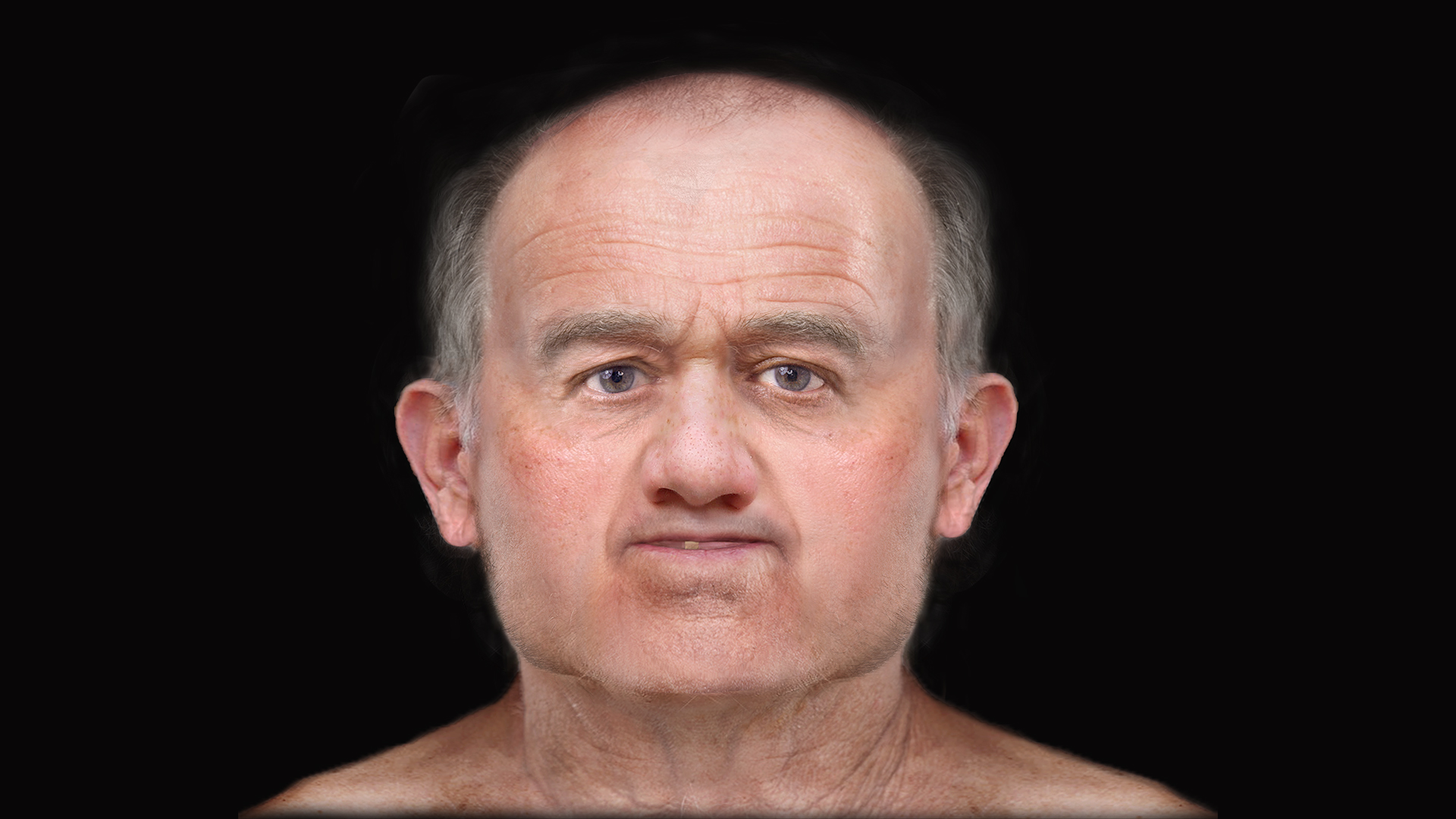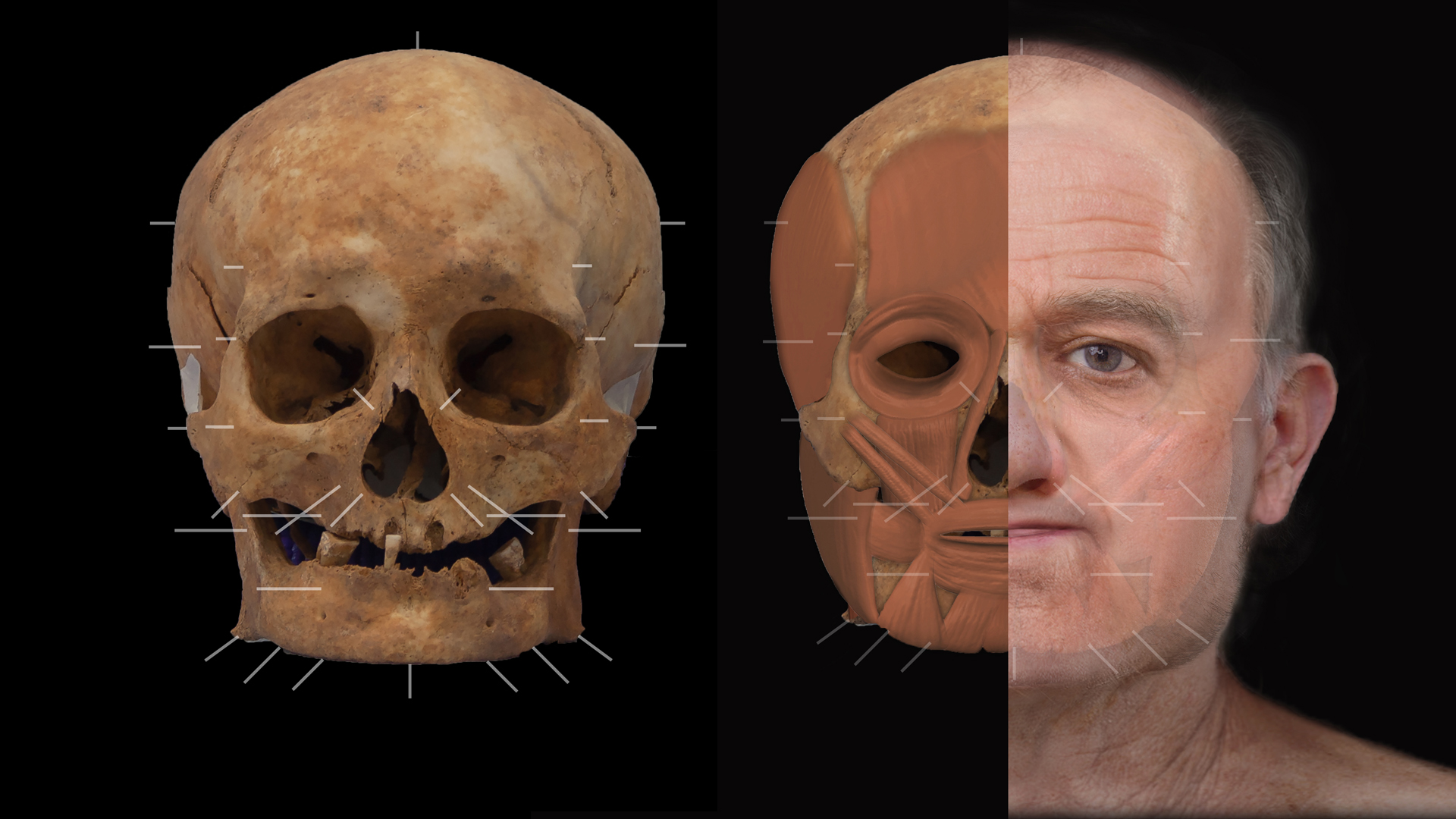Medieval Scottish Man Who Died 600 Years Ago Was Short and Balding, with Bad Teeth and Back Problems

Archaeologists have reconstructed the weathered face of a balding, middle-age man suffering from back trouble and severe dental disease. He died more than 600 years ago and was buried in Aberdeen, Scotland.
Using facial reconstruction technology, researchers crafted a digital model that offered a glimpse of the man — known as "Skeleton 125," or "SK125" — showing what he may have looked like in life, Aberdeen City Council representatives said in a statement.
The result reveals the 46-year-old man's face, with blue eyes that are set close together and a jaw that is missing many of its teeth. The skull's condition indicated years of serious tooth and gum problems, which led to tooth loss, a chronic abscess and cavities, according to the statement.
Related: Under Her Spell: A 'Witch' Shows Her Face, 300 Years After Her Death
SK125's remains, along with 59 other complete skeletons and more than 4,000 human bone fragments, were found during excavation work to expand the Aberdeen Art Gallery in 2015. The building was constructed in 1885 on the site of a friary and a church, both built in the 13th century and destroyed in 1560, council representatives said.
Workers digging outside the art gallery uncovered a charnel house made of red brick containing three Victorian coffins that held hundreds of human bones. Further excavation inside the gallery uncovered 60 skeletons in individual graves, the oldest of which — including SK125 — dated to between 1050 and 1410, according to the statement.
"The disarticulated remains found in the red brick charnel house were redeposited during the late 19th century," said archaeologist Paula Milburn of the AOC Archaeology Group, a private archaeology company that excavated at the site.
Sign up for the Live Science daily newsletter now
Get the world’s most fascinating discoveries delivered straight to your inbox.
"SK125 was chosen for reconstruction as he was one of the skeletons in an individual grave with a well preserved skull. His level of preservation meant that we were confident that he would be able to tell us lots about his life," Milburn told Live Science in an email.
Osteologist Mara Tesorieri pieced together a picture of SK125's overall health by examining his skeleton, Milburn said. Along with his tooth and jaw troubles, he showed signs of degenerative joint disease in his middle and lower back, possibly causing back pain. He stood between 5 feet 2 inches and 5 feet 5 inches (159 to 166 centimeters) tall, which was shorter than average for Scottish men during that period, according to the statement.

A face from the past
To build the digital model of SK125's face, forensic artist Hayley Fisher photographed and measured his skull, working out how the muscles would have been attached, Milburn explained.
"Using this information, she was then able to overlay the skin and give us the person we see today. Although his hair and eye color are Hayley's interpretation, the measurements ensure that what we are seeing is accurate," Milburn said.
Most of the skeletons under the art gallery belonged to adults, from 18 to 46 years old and older, and many of them showed signs of dental disease, city council representatives reported.
What's next for SK125 and his graveyard neighbors? Researchers will use radiocarbon dating to pinpoint a more accurate date range for some of the skeletons, including SK125, "who is currently being placed in a date range on the basis of associated dated skeletons," Milburn said in the email. Scientists will also examine animal bones and other artifacts found at the site, including coffin fittings, personal ornaments, and bits of pottery and glass, according to the statement.
"Once everything has been analyzed we will be able to draw together a detailed picture of the people who were buried here," Milburn said.
- Photos: The Reconstruction of Teen Who Lived 9,000 Years Ago
- Ancient Wari Queen Brought to Life with Stunning Re-Creation of Head
- Photos: See the Ancient Faces of a Man-Bun Wearing Bloke and a Neanderthal Woman
Originally published on Live Science.

Mindy Weisberger is an editor at Scholastic and a former Live Science channel editor and senior writer. She has reported on general science, covering climate change, paleontology, biology and space. Mindy studied film at Columbia University; prior to Live Science she produced, wrote and directed media for the American Museum of Natural History in New York City. Her videos about dinosaurs, astrophysics, biodiversity and evolution appear in museums and science centers worldwide, earning awards such as the CINE Golden Eagle and the Communicator Award of Excellence. Her writing has also appeared in Scientific American, The Washington Post and How It Works Magazine. Her book "Rise of the Zombie Bugs: The Surprising Science of Parasitic Mind Control" will be published in spring 2025 by Johns Hopkins University Press.









